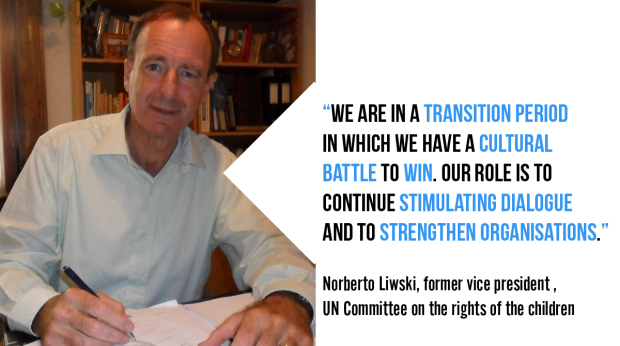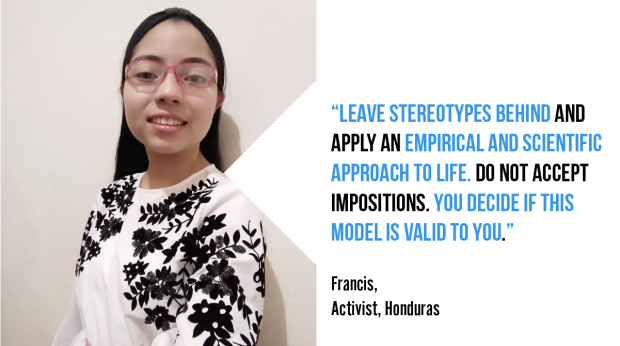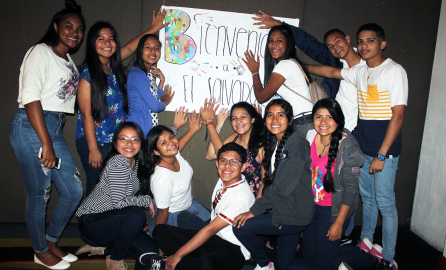Este artículo también está disponible en Español.
The world celebrates the anniversary of the Declaration of Children’s Rights adopted on 20 November 1959 by the UN General Assembly. Although one in three people worldwide is a minor, most societies still undervalue the opinion of children and teens. However, young activists like Greta Thunberg and Francisco Vera1 prove that – for a better world – their voices matter.
The proactive contribution of the Latin America and Caribbean region (LAC) to protecting children and youth is not new. Norberto Liwski, former vice president of the UN’s Committee on the rights of the children, and member of the Argentinian delegation for the Convention on the Rights of the Child explains, “the Convention, and in particular articles 7 and 8, integrates the current debates and needs of the region after a dark period in our history. Notably related to the registration and identity of children.”

This Convention, the UN resolution 836(IX), and the EU action on children’s rights, are some of the instruments available to protect and advocate for one of the most vulnerable communities in our societies: children, and adolescents2. In addition, the coalition of local authorities, CSOs and foundations is essential in implementing programmes and initiatives which positively affect girls and boys within this context.
The EU co-funded project Tejiendo Redes Infancia (Weaving Childhood Networks) in the LAC region3 is one such example. The project contributes to changing public and budgetary policies; challenges social and cultural structures and empowers direct participation of boys and girls to articulate political awareness.
Like the Me Too or the Fridays for Future global movements, this one has extended its geographical scope thanks to its digital presence. So far, it is present in 20 LAC countries4, shaking some of the pillars of our society through hashtags and other interactive tools.
Best practices of Tejiendo Redes Infancia:
- Empowering intergenerational dialogue: to facilitate understanding and promote long term solutions;
- Strengthening coalitions that participate in the project: empower and unite stakeholders to tackle problems and link priorities;
- Using media and social networks: to promote collective action that goes beyond political positioning.
1. Empowering intergenerational dialogue
Tejiendo Redes Infancia is rooted in intergenerational dialogue. Juan Martín Pérez García, the project’s regional coordinator, explains, “our society follows the cult of adulthood. Girls and boys do not count as decision-makers. We hear them but do not listen to their demands.” But, he continues, “intergenerational dialogue doesn’t disavow adults but recognises the value of our counterpart, no matter how old this person is.”

Fernando, a 14-year-old Mexican activist with more than four years’ expertise in disappeared people, agrees with Juan Martín Pérez García, “it is not easy to reshape rooted habits or customs, but being open to hearing other voices promotes respect and diversity.”
“We have other opinions and different backgrounds, but to disagree is not an obstacle. Together, we can create opportunities from the current challenges,” adds 15-year-old Honduran activist, Francis.
Norberto Liwski complements, “it is a dynamic and productive process in which we are not only reconstructing our collective memory from the past, but also building new political and cultural strategies for all.”
COVID-19 has both profound and immediate effects on children and teens. However, according to Juan Martín Pérez García, the pandemic has also represented an opportunity to learn from each other. “Teleworking and online learning events were possible in most cases thanks to young people’s understanding of technology.” In his view, “If it hadn’t been for the technical expertise of young people, the parents would not have been able to work virtually. Families accepting this intergenerational dialogue have strengthened their ties and become more resilient.”
2. Strengthening coalitions that participate in the project
The focus of Tejiendo Redes Infancia is to strengthen the active participation of organised groups of girls and boys to empower the national networks involved in the project. To this end, the project has organised training and capacity building workshops. Juan Martín Pérez García says, “institutions need a systematic change to evolve and progress. Without the empowerment and replacement of its staff, organisations become vertical and hierarchical structures.”

In this context, Juan Martín Pérez García recognises the importance of the technical support received by European partners to set up a consultation model to avoid institutional conflicts and facilitate professional mediation. This support establishes new dynamics in which the agendas of different movements are interconnected, and thus tackle current challenges.
“We invite children and youth to contribute as experts in public policy debates with other authorities on the topic. This changes paradigms as most often their contribution is limited as victims of the process,” adds Juan Martín Pérez García. The advocacy action taken by these boys and girls includes their participation in international spaces such as the Second Inter-American Forum on National Systems for the Comprehensive Protection of Girls, Boys and Adolescents, among others.
The active participation of youths in a wide range of topics helps to extend the movement and to share agendas with other movements. This results in tackling challenges such as women’s and girl’s rights and the environment and working together towards common goals. Or, as Fernando says, “together we generate knowledge.”
“Tejiendo Redes Infancia built upon existing synergies of networks within the region, but the most important thing is that this created new agendas with other stakeholders,” says Norberto Liwski.
Francis agrees, “we come from different countries, and we work on different topics, but we all want to achieve the same objective.”
3. Using media and social networks
COVID-19 has forced the digital shift in many development projects and initiatives – Tejiendo Redes Infancia is no exception. However, the pandemic represented an opportunity for the project to strengthen its strategic alliance with leading online companies – like Facebook, Instagram, Twitter and Google – to spread their ideas.

Like other social movements, Tejiendo Redes Infancia used hashtags in their activities like the 130 seminars #NiñezPrimero (ChildrenFirst) with more than six thousand views in 35 countries across the LAC region and Europe.
Although there is a specific emphasis on the channels used, content is equally important. “Boys and girls were instrumental in understanding and debating complex issues within our societies; attracting parents, institutions, organisations, teachers, among others,” explains Juan Martín Pérez García. This active involvement of youth led to 14 webinars, exclusively created by 40 minors around the same age as Fernando or Francis.
“Tejiendo Redes Infancia dared to discuss complex topics avoided by many others such as the unbalanced distribution of COVID-19 vaccinations. This proactive and brave approach put them at the forefront of so many topics and proved their commitment to society,” says Norberto Liwski.
Again, this project was a pioneer in creating Ollin.TV, a collaborative TV channel, which aims to be a reliable source for those interested in journalism focused on and produced by children. “We do not receive instructions about how to say things or what content to produce. We are reporters. We conduct research and interviews by ourselves”, says Francis proudly. Fernando, currently studying journalism and law at a university in Mexico, agrees and complements, “I am a moderator and panellist in Tejiendo Redes Infancia activities #NuestraVozCuenta (OurVoiceMatters) and #NiñezObserva (ChildrensWatch). It is a great opportunity to put into practice what I learn at University.”
The project is concluding after five years of implementation, but the movement doesn’t stop here. “We are a big family bringing change to society, and we should keep doing it,” says Francis. Fernando is already thinking about extending the network, “in the LAC region, connectivity is not guaranteed. We need to think about how to reach children and youth in remote areas without internet or even electricity.” Norberto Liwski agrees and recommends to other development practitioners that “our focus should be on tackling imbalances in our societies. These are the real source of discrimination.”
Click on the play button below to watch our video about Tejiendo Redes Infancia.
Have you been involved in relevant interventions for the promotion of children's rights?
What was your approach?
Did you meet any challenges, and how did you address them?
Leave your comment below!
|
More about Tejiendo Redes Infancia
Weaving Childhood Networks promotes the creation of spaces, where everybody involved reflects on the extent to which the action taken by the States - from the signing of the Convention on the Rights of the Child (CRC) to the present - has allowed a real change in the quality of life of girls, boys and adolescents in the region. Among the priority issues monitored are: • Violence • Adolescents in conflict with criminal law • Right to health • Education rights • Right to identity • Right to live with family • Digital citizenship and internet security • Labour, economic and sexual exploitation • Investment in childhood and adolescence • 2030 Agenda and Sustainable Development Goals The Strategic Plan develops the mechanisms for influencing public policies, legislation, public investment and the practices of state agents linked to guaranteeing the rights of girls, boys and adolescents. This plan was developed on the following bases: • Recommendations of the Committee on the Rights of the Child (CRC-UN) • The Universal Periodic Review of each of the States • Signature and ratification processes of the Third Optional Protocol to the Convention on the Rights of the Child. • Progress in applying the recommendations of the United Nations Study on violence against children and adolescents. • The Inter-American Human Rights System. • Implementation of the National Systems for the Comprehensive Protection of Girls, Boys and Adolescents in the region. • Political, economic and social trends prevailing in the countries. Related videos:
|
Credit: Video © Capacity4dev | Photo © Derechos Infancia México A.C. / Tejiendo Redes Infancia, 2021
1 Fernando Vera is a well-known Colombian 12-year-old eco-activist.
2 There is still room for improvement to guarantee that children and teens are saved from poverty, discrimination and neglection. Read Save the Children 2021 Global Childhood Report.
3 In 2016, The Network for the Rights of the Child in Mexico and the European Union signed a Framework Partnership Agreement setting up the Tejiendo Redes Infancia project with the financial support of the EU, the Swedish Association for International Development (SIDA) and Save the Children.
4 Tejiendo Redes Infancia is implemented by national coalitions in Argentina, Bolivia, Brazil, Chile, Colombia, Costa Rica, Cuba, Ecuador, El Salvador, Guatemala, Honduras, Mexico, Nicaragua, Panama, Paraguay, Peru, Puerto Rico, Dominican Republic, Uruguay and Venezuela.






Log in with your EU Login account to post or comment on the platform.